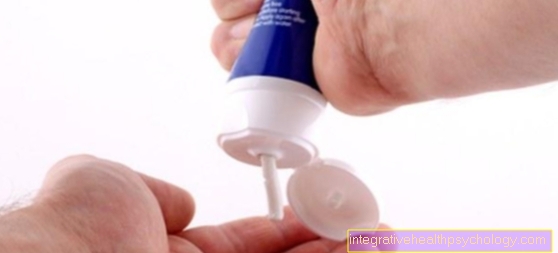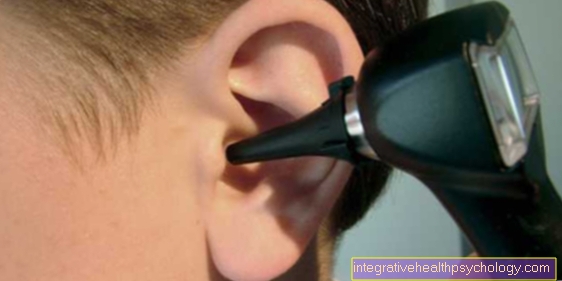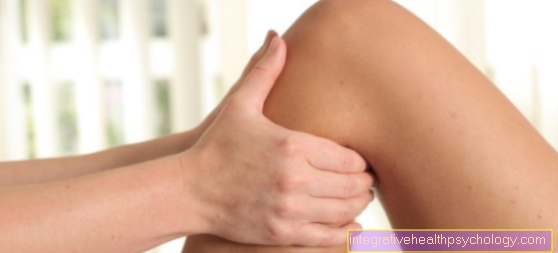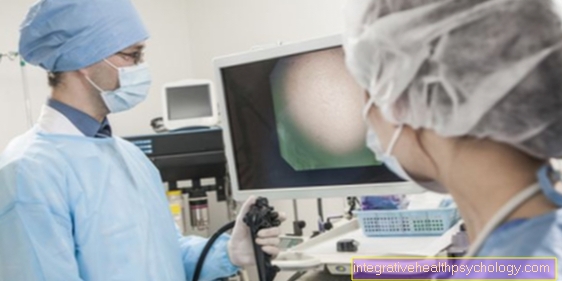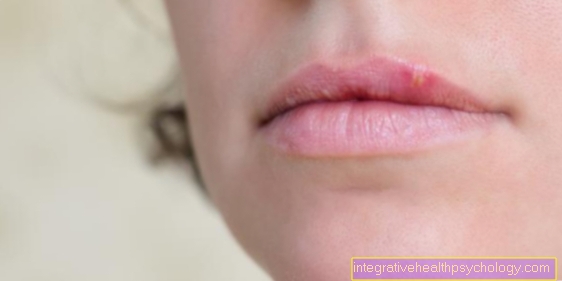Boils in the genital area
definition
A boil is a form of abscess, i.e. an inflammation of a hair follicle, which is usually triggered by bacteria. This purulent inflammation occurs in the area of the hair follicle and spreads to the surrounding structures and fatty tissue. The most common boils are in the neck, chest area, enlarged genital area (groin, inner thigh), armpits and nose.

Symptoms of a boil in the genital area
A boil usually only becomes noticeable when the inflammation begins. The area around the resulting boil is reddened and warmed. In addition, the pressure in the area of the affected hair follicle increases, which becomes painful. You can hardly sit, urinate and especially chafe jeans pants and it is very painful. The pus formation can also be seen from the outside: a whitish center is visible in the reddening caused by the inflammation. It is strongly advised not to press on a boil and try to open it like a pimple by squeezing it out. This can lead to much larger infections. The pus from the boil usually drains on its own.
You might also be interested in: Furunculosis
Pain with boils in the genital area
A boil is an active inflammation and is therefore often associated with severe local pain that increases with movement and stress. The more a boil is filled, the more the skin is under tension. Boils in the genital area are particularly uncomfortable, as there is increased stress here due to the step movement and tight clothing. In addition, the genital area is very well supplied with nerves and pain is felt more strongly there. A doctor should be consulted if the pain is severe.
Particularities in men
Basically, boils do not differ in men and women. A common problem in men is not only evident with boils in the genital area, but in many medical cases. Men go to the doctor much less often and try to cope on their own. Since boils occur particularly when the body's immune system is weakened, the increased occurrence can be an indication of an unrecognized condition such as diabetes. Such underlying diseases can be identified and treated with regular checks. There is also a feeling of shame, which is more common in men, when symptoms occur in the genital area of all places.
Men have more boils than women, especially in the anus area, because men have more hair in that area. Since the area is also difficult to see, the boils are often only noticeable when they become painful. Furthermore, men often sweat more than women and the triggering bacteria, staphylococci, multiply more in warm, humid regions. These conditions are given in the genital area especially in men by sweating.
Therapy of a boil in the genital area
A general therapy recommendation for boils is to rest the affected body parts and to protect them. This is especially difficult in the genital area. But in order to dampen the painful external impact, it helps to pad the boil with gauze bandages so that the clothing does not rub any further. It must be emphasized again and again that under no circumstances should the boil be pressed. Most of the time, the foci of pus empty on their own. Then it is important to disinfect the resulting wound regularly; wound and mucous membrane disinfectants are particularly suitable for this, as it does not sting even on wounds.
Externally, pull ointments (e.g. Ichtholan® ointment) are sometimes used, with the cost-benefit of the pull ointments being assessed differently. Pull ointments are anti-inflammatory ointments that promote blood circulation, reduce the flow of sebum and promote the absorption and uptake of dead cells. Mostly they are made from oil shale. An important substance is the ammonium bituminosulphate, which is contained in the pulling ointment. The pull ointment is intended to promote the spontaneous breakthrough of the boil. Only shale oil sulfonates up to a concentration of 20% should be used in the intimate area. However, the use of pull ointment is to be questioned critically, as the doctrine is also held that it softens the skin over a boil and thus promotes the development of an abscess. The pull ointments are also to be viewed critically due to the possible allergic reactions that can occur due to the components of the ointment. In general, the use of pull ointment is therefore not recommended today.
Read more on the topic:
- Ichtholan®
- Ointment for a boil
If a boil does not heal by itself, a doctor should be consulted who will open the boil. If the patient suffers from illnesses that weaken the immune system or the boils appear on the face (especially nose and upper lip), a doctor should be consulted immediately. Many doctors are certainly familiar with the correct therapy, but a surgeon is best suited for the invasive therapy of a boil, as he is not only well versed in operations but also in wound healing. Pronounced forms of boils are opened with a scalpel under local or regional anesthesia, the pus can now come out of the boil and strips of gauze that have been soaked in an antibacterial solution are placed in the wound. To be on the safe side, a smear can be taken from the opened boil and the pathogen can be precisely identified.
Read more on the subject at: Operation of a boil
At an advanced stage, boils can also be covered with systemic antibiotic therapy to prevent the pathogen from spreading throughout the body. The previously obtained wound swab and the resulting determination of the pathogen contribute to the optimization of the antibiotic therapy, as a specific drug can be used. The wound is closed with a bandage. However, the gauze strips and bandage must be renewed daily and the wound checked for signs of inflammation (warmth, redness, swelling, tenderness, impaired function).
Complementary medicine also knows active ingredients that can favorably influence the course of a boil. The antibacterial chamomile is used in the form of baths or compresses to accelerate the ripening of the boil.
Other natural remedies that have an antibacterial and anti-inflammatory effect are:
- Marigold
- Witch hazel
- Sage leaves
- Ribwort plantain
U.N - Arnica.
From these funds, poultices or tinctures can be made that can be applied on the boil.
Read more on this topic at: Treatment of a boil
Antibacterial aftershave balms can also help disinfect and soothe the skin. This is especially true after hair removal. One example of this is the Dr. Severin Body After-Shave Balm from the pharmacy.
Which doctor can treat boils?
In most cases, conservative therapy is carried out by your family doctor or a dermatologist. Microbiologists are also involved, as a precise analysis of the bacteria is sometimes necessary. If an operation is necessary, a general surgeon is called in. In principle, any doctor can treat a boil. Especially with women, the gynecologist is confronted with the disease more often. Most specialists, however, refer to the treating family doctor.
When does a boil in the genital area need to be operated on?
In many cases, a boil can also be treated conservatively in the genital area. In medicine, however, the principle is that pus must always get out of the body. If this does not happen on its own, minimally invasive treatment can be used. The family doctor can try this on site in the practice. The doctor will scratch the boil with a sterile scalpel and the pus will drain away more easily. If the boil is too deep, proper surgery can be performed. The boil can be opened in the hospital under mostly local anesthesia. A sharp spoon is used to remove pus and broken tissue. This treatment ensures that no accumulation of pus remains in the wound, which could provoke a relapse.
Whether an operation is necessary depends on the size and location. Surgery is advisable, especially for those affected with weakened immune systems, as otherwise the boil could open inwards and blood poisoning could result. In the intimate area, some affected people also decide to have an operation themselves, as the boil there is perceived as very annoying and restrictive. An operation should always be considered if there is no other improvement.
Read more on the subject at: Operation of a boil
Special features of therapy in women during pregnancy
If the boils occur during pregnancy, special care should be taken with the use of ointments and medication. It is important that the agents used do not harm the child by being transmitted to the child via the bloodstream and placenta. In any case, a doctor should decide on therapy for the boil so as not to harm the child. Of course, the same rules apply to independent therapy and hygiene as to everyone else.
Particularly during pregnancy, care must be taken that the boil does not become inflamed or spread. At this point, too, it is important to point out that the boil should not be expressed. Either the position opens on its own or is opened by a doctor.
Homeopathy for boils in the genital area
A boil can heal on its own and those affected can use homeopathic remedies to help. Homeopaths recommend the Hepar sulphuris calcareum and Pyrogenium for the beginning and when the swelling increases, Siegesbeckia orientalis.
If the pain increases and there is no improvement after three days, a doctor should be consulted, as conventional medical treatment is then necessary. Diabetics should see a doctor directly and not attempt self-treatment.
Home remedies for boils in the genital area
There are various home remedies for boils. A used black tea bag can be placed directly on the boil. The contained tannins could kill the triggering bacteria. While the boil is emptying, a cotton ball dipped in salt water can aid emptying. A very old home remedy is kale, which is cooked and placed on the boil and stuck on. Tea tree oil can also have an antibacterial effect and promote healing. St. John's wort is also used as a remedy.
Tea tree oil for boils in the intimate area
Tea tree oil is one of the alternative home remedies that can be used against boils. Tea tree oil is an ancient remedy that has anti-inflammatory effects and can kill bacteria. It can also accelerate the healing of the skin. Since some allergic reactions to tea tree oil have been reported, the tolerance should be tested in advance. A small amount of tea tree oil can be applied to healthy skin for this purpose. If there is no improvement, a doctor should be consulted after three days at the latest.
Read more on this topic at: Tea tree oil
Development of a boil
They are especially common when the immune system is weakened. Then the pathogens migrate along the hair or the sweat glands into the tissue and trigger an infection. The pus is created by the destruction of the tissue cells and the presence of the immune cells. First, the pus builds up under the skin and increases the tenderness of the area. However, the pus can find its own way out and break through the skin. The union of several boils is called a carbuncle.
The development of a boil is favored by various factors. On the one hand, a weak immune system is a possible cause for the development of boils, since the bacteria are not fought efficiently enough. On the other hand, metabolic diseases such as poorly controlled diabetes mellitus favor the formation of boils. Personal hygiene also plays a role in the development of boils. Since pressure points or wounds caused by chafing poorly fitting clothing and underwear can trigger boils, this should be avoided.
Boils can be caused by shaving, especially in the genital area, if there is no disinfection after shaving and germs penetrate the subcutaneous tissue through the micro-lesions caused by the shave. Boils quickly develop, especially in the intimate area, due to the numerous pathogens and the warm, moist environment.
Further causes can be found under Causes of a boil.
Complications of a boil in the genital area
Uncomplicated boils that open up and heal on their own show a favorable course. Especially with boils in the genital area, it is very important to prevent the bacteria from the pus of a burst boil from being transferred to other parts of the body or even sexual partners / contact persons. Good hygiene of the part of the body affected by the boil is therefore essential.
It is less favorable to go there if the boils appear several times (Furunculosis) or several boils appear side by side and merge into one large, very painful carbuncle. It is very important not to press the boils, as this can worsen the inflammation and create an abscess. Then a surgical procedure is necessary under general or regional anesthesia, in which a larger incision opens the abscess cavity and not only the pus but also the dead tissue areas are removed. As the wound progresses, it remains open so that more pus can drain away. Antibiotics can also be applied locally to the wound in the form of platelets, sponges or chains. In addition to swelling of the lymph nodes, a particularly serious complication when the pathogen spreads in the body is blood poisoning (sepsis) be.
Read more on the subject at: Abscess in the genital area
How can you prevent a boil in the genital area?
To prevent boils from developing and spreading, a few things are important. First of all, good personal hygiene is very important to prevent boils. Especially when the boils have been opened, it is more important than ever to ensure that the wound is kept clean and regularly disinfected. Furthermore, the underwear should be washed regularly with hot (60 degrees) to kill the germs. In addition, the towels and bed linen should be washed regularly. Since many boils are also caused by shaving, care should be taken to disinfect the freshly shaved areas so that no pathogens can penetrate the small skin lesions. In addition, soft clothing and non-abrasive underwear are important for prophylaxis.
Summary
Hygiene can prevent boils from developing, but does not prevent them from occurring entirely. When boils occur, it is important not to manipulate manually, i.e. squeeze or press. Natural remedies or pulling ointment can be used to encourage spontaneous opening - but in a controlled manner, without causing an abscess. If there is no spontaneous opening, it is advisable to consider surgical therapy. In the early stages, a small operation under local anesthesia is enough to open the boil. Further treatment includes local or systemic antibiotic therapy and strict hygiene of the affected area.



